- All Posts
- /
- Email in the Product Loop

Email in the Product Loop
News and Updates-
 Jimmy Daly
Jimmy Daly
-
Updated:Posted:
On this page
Customer experience is more holistic than most businesses account for. The product loop – a phrase that helps put customer experience in perspective for online businesses – extends far beyond the core application or service. It is also comprised of customer support, email marketing, notifications, advertising and more. Anything that could trigger action, emotion or apathy regarding your business falls within the product loop.
Email is a part of the product loop where many businesses struggle. Whether you plan for it or not, email is central to the customer experience. Customers typically receive a welcome message, onboarding emails and a newsletter. As they use your product or app, they’ll receive notifications too. Add in receipts, invoices, services outage notifications and pretty soon, it’s difficult ensure you’re presenting a consistent and enjoyable experience. A cluttered email strategy makes for a disjointed product loop.
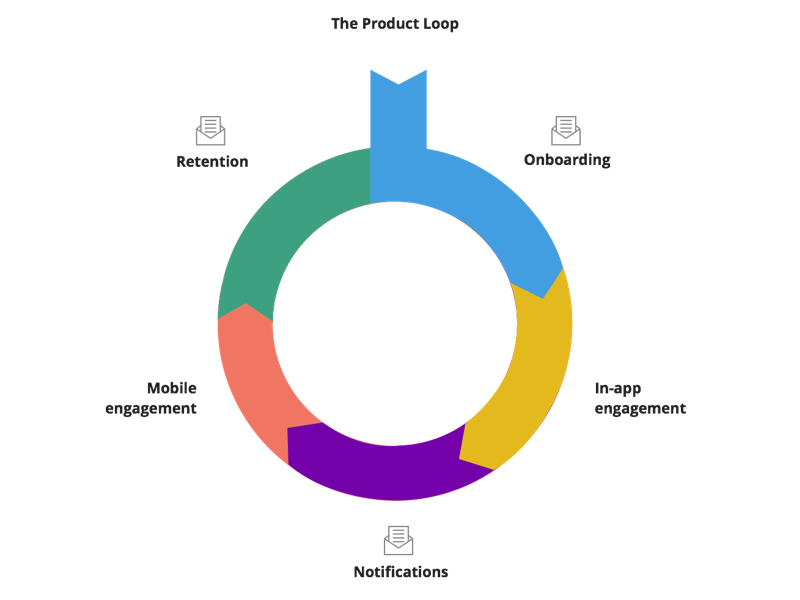
What we’ve found through observation and measurement is that the smartest businesses keep it simple. They, for example, don’t send too many newsletters and only send notifications when customers are inactive. They add value, even at the expense of losing engagement within their app or store.
Furthermore, the emails they send are incredibly consistent with the brand’s style, tone and agenda. Take the Airbnb emails we’ve talked about so much on this blog. The Airbnb team is hell-bent on creating a great experience. If the channel, platform or medium is even tangentially related to Airbnb, the experience will be enjoyable.
We pulled example emails from a few businesses that really understand how important email is to the customer experience. Each takes a unique approach but all put the customer first.
Slack – Focus on Inactivity
A company like Slack isn’t using email to educate, create brand awareness or drive clicks. Email falls squarely within their product loop. In fact, aside from a few onboarding emails, notifications are the only emails most customers ever get from Slack.

Slack notification emails are designed to get users back in the app. The look and feel, as well as the scarcity, is indicative of this strategy.
For Slack, it’s all about driving engagement. CEO Stewart Butterfield told The Verge, “The [metric] we track most closely is our daily active users, because if people aren’t using it every day it’s not really being used.”
Triggering these notifications is part of larger strategy designed to get users engaged. Slack wisely tracks engagement in their apps to know when to send these emails. For example, logged-in users might receive an email notification if they don’t respond to a mention.
Even more impressive, Slack includes a brief activity log from your inactive time and allows you to control notifications.
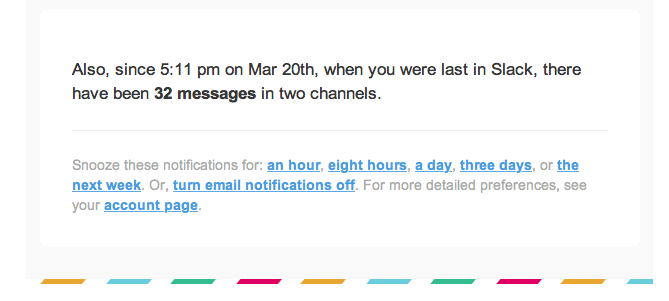
Giving users control over the emails they receive is an indicator that Slack is all about value. They do their best to send only as many emails as you need but if you can get more value from greater or fewer emails, it’s encouraged. This could very well mean fewer emails from Slack and maybe even less time in the app. That’s okay as long as Slack is measuring customer satisfaction rather than opens and clicks.
Product Hunt – A Homogeneous Experience
Product Hunt is a perfect example of a community that delivers value on multiple mediums. While the main site is the activity hub, their mobile app and newsletter are complementary resources for users who prefer information on-the-go. This makes Product Hunt a community, not a destination.
Ryan Hoover, Product Hunt founder and Hooked: How to Build Habit-Forming Products co-author, understands the importance of email as a habit-building tool. “We check our email several times a day. If done right, email products can become a part of users’ daily habits,” he writes on his personal blog. In fact, Ryan started Product Hunt as a standalone newsletter before building it into a membership site.
Lead Hooked author Nir Eyal defines a habit as “a behavior done with little or no conscious thought.” Checking email is a habit already ingrained in Product Hunt’s target audience, making it the perfect external trigger for a daily routine.
To make this work, the platform’s look and feel of has to be consistent everywhere. Product Hunt is familiar to users in every medium.
Consistency, along with frequency, make Product Hunt’s offering an easy habit to pick up. And in the absence of any event tracking, it’s an easy strategy for any marketer to replicate.
Trello – Mirror Product Functionality
Trello’s collaboration tools rely on email to keep users updated. But they’ve taken ’email in the product loop’ a step further by adding functionality, thereby weaving email directly into the fabric of the product.
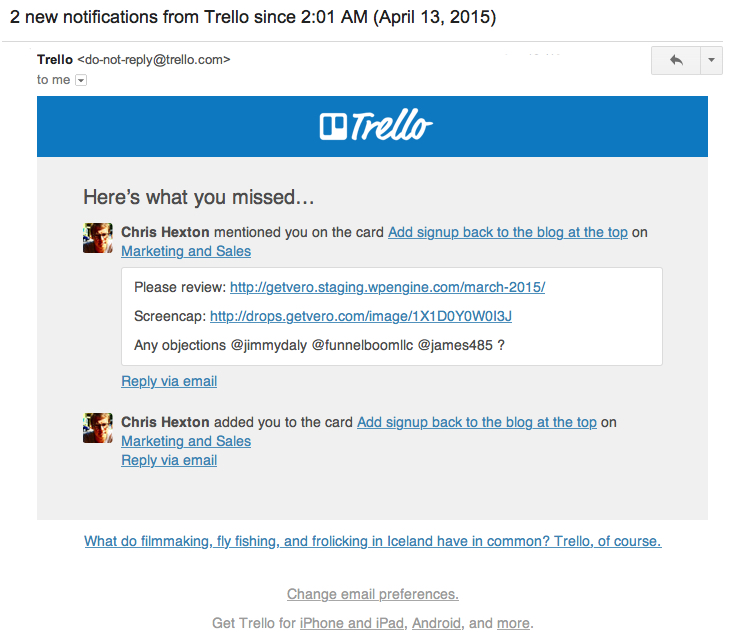
Users can reply directly to comments on each board, meaning they spend less time in Trello but get more value from it. Stella Garber, Trello’s VP Marketing, says this is a no-brainer. “Replying to comments by email is simply easier from a user experience perspective than making people sign into the app. We want Trello to be accessible anywhere.”
Now that is a smart way to put email to work.
Trello, like Slack, gives customers the option to receive more or less emails in the footer of every email. But unlike Slack, they don’t push customers towards the app since the value is in ongoing collaboration, not real-time communication. They also integrate their blog content into notifications. New posts are included in all notification emails, neatly tying education back to the product.

Notification emails like this aren’t just transactional messages, they are part of the product. Trello treats email like a product feature, carefully tweaking the UI, functionality and copy until everything works together seamlessly.
Amazon – Timing Is Everything
“We’ve had three big ideas at Amazon that we’ve stuck with for 18 years, and they’re the reason we’re successful: Put the customer first. Invent. And be patient.”
That’s Amazon CEO Jeff Bezos on how to build a great business. We’ve spent a lot time dissecting Amazon emails on this blog for good reason. The experience is knitted together by a singular goal: making customers happy.
One of the many manifestations of that goal is customer reviews. A study from Dimensional Research found that reviews impacted purchasing decisions for 90 percent of consumers. It worked for Amazon in the early days and it still works today.
Email is the primary driver of these reviews. I received the email below two months after purchasing a book. I checked a few other books I’ve purchased on Amazon and found that I get the review email about 60 days after the purchase. That tells me that Amazon knows this is the sweet spot for book reviews. It’s enough time to read the book but not too long that I’ve forgotten about it.
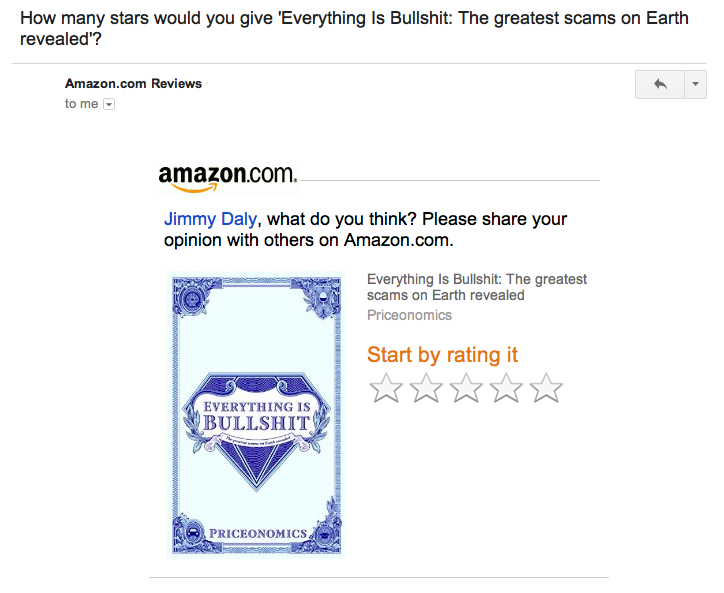
The timing differs by product. For example, I also purchased a chew toy for my dog. That follow-up email arrived 30 days later. When I bought socks, the review email came 40 days later. Amazon carefully tracks this data to ensure every email arrives at the right time.
There’s a lot of information about engagement for SaaS apps but it’s just as important for e-commerce. For Amazon, email is a feature, not a channel.
Blue Apron – Proactive Customer Support
The product loop doesn’t have to be connected by hyperlinks. For most businesses, the experience extends far beyond a laptop or smartphone. But even when the connection isn’t seamless, email can bridge the gap.
For a business like Blue Apron, a service that delivers ready-to-cook food, the customer experience takes place in the kitchen.
They take a support-heavy approach to email. In addition to weekly shipping confirmation emails and plenty of food porn, they send proactive customer support emails. This keeps the lines of communication open and accessible.
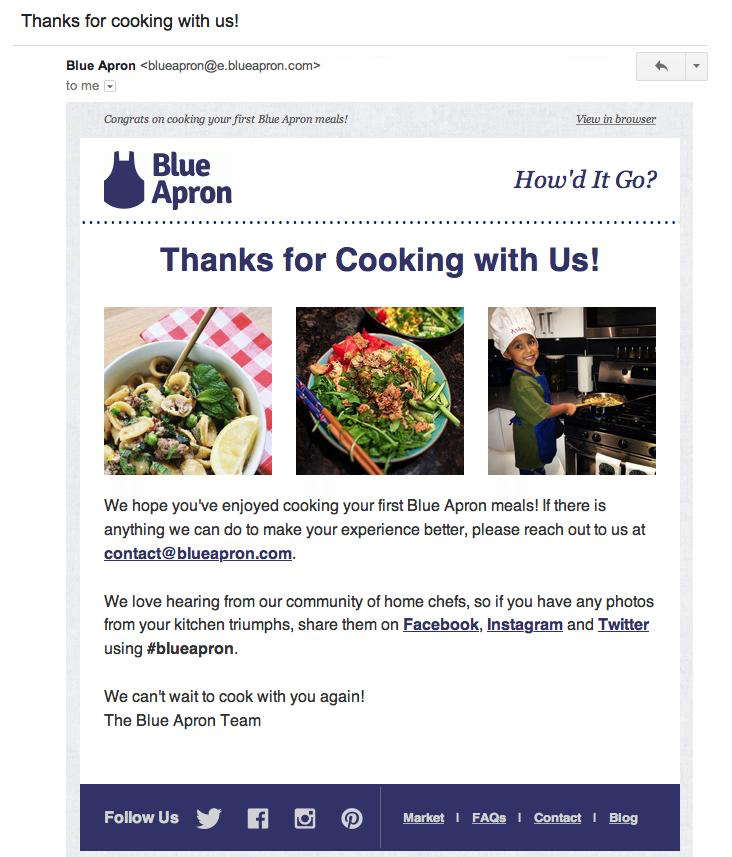
Whether your business is online or offline, communication is vital to happy customers. Considering all the things that can go wrong while cooking a new recipe, emails like this are a must for Blue Apron.
Think about your SaaS app, store, site or community – where could customers get lost, confused, frustrated or overwhelmed? (If you can’t think of any, you aren’t thinking hard enough.) Triggered emails like this one help alleviate that pain proactively, making it a core strategy for happier customers.
Vero makes it easy to trigger emails based on behavior, inactivity, purchase history and more. Check out free trial to kick the tires free for 14 days.

